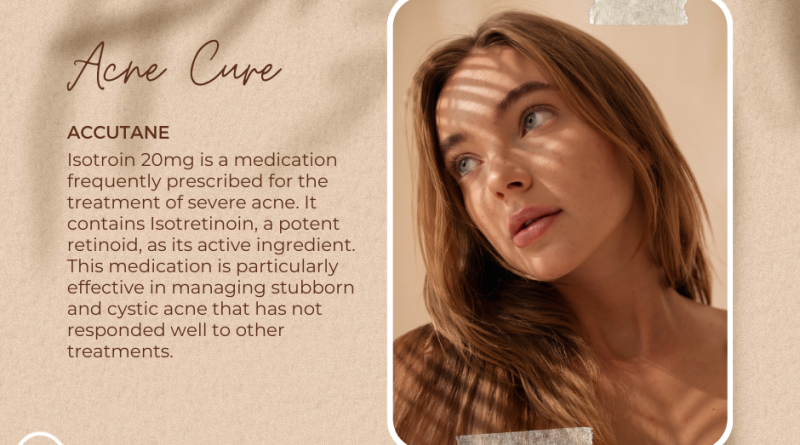The Truth About Skin Acne Cause and Treatment Option
Acne is a common skin condition that affects millions of people worldwide, regardless of age, gender, or ethnicity. While it’s often associated with puberty and adolescence, acne can persist into adulthood and can be a source of frustration and embarrassment for many.
The truth about acne is that it’s more than just a cosmetic issue. It can have a significant impact on a person’s self-esteem and mental well-being. Buy isotretinoin online for better acne cure. Understanding the causes and treatment options for acne is essential for managing this condition effectively.
Types of Skin Acne:
Skin acne is a common skin condition that occurs when hair follicles become clogged with oil and dead skin cells. There are several types of acne, each with its own characteristics and treatment approaches. Here are some of the most common types of skin acne:
Comedones:
Comedones are non-inflammatory acne lesions that occur when hair follicles become clogged with oil and dead skin cells. There are two types of comedones:
- Open comedones (blackheads): These occur when the clogged pore is open to the skin’s surface, and the trapped oil and skin cells oxidize, giving them a dark appearance.
- Closed comedones (whiteheads): These occur when the clogged pore is closed, trapping the oil and skin cells beneath the skin’s surface, resulting in a white or flesh-colored bump.
Papules:
Papules are small, red, raised bumps that occur when the hair follicle becomes inflamed. They are usually tender to the touch and can be a sign of more severe acne developing.
Pustules:
Pustules are similar to papules but contain pus, which gives them a white or yellowish appearance. They are often filled with white or yellow pus and can be painful.
Nodules:
Nodules are large, solid, painful lumps beneath the surface of the skin. They occur when the hair follicle becomes severely inflamed, and they can be difficult to treat and may lead to scarring.
Cysts:
Cysts are large, pus-filled lumps beneath the surface of the skin. They are similar to nodules but are softer to the touch. Cysts are the most severe form of acne and can lead to scarring if not treated properly.
Acne Conglobata:
This severe form of acne is characterized by large, interconnected nodules and cysts that can be extremely painful and may cause scarring.
Acne Mechanica:
This type of acne is caused by friction, pressure, or heat on the skin. It is often seen in athletes or people who wear tight clothing or equipment that rubs against the skin.
Acne Rosacea:
Although technically not acne, rosacea can resemble acne and is characterized by redness, flushing, and small, red bumps on the face. It typically affects middle-aged adults and can be triggered by certain factors such as sun exposure, spicy foods, and alcohol.
Understanding the different types of skin acne is essential for determining the most appropriate treatment approach. It’s important to consult with a dermatologist to develop a personalized treatment plan based on your specific type and severity of acne.
Causes of Acne:
Acne develops when hair follicles become clogged with oil and dead skin cells. Several factors can contribute to this process, including:
Hormonal changes:
Fluctuations in hormone levels, such as those that occur during puberty, menstruation, pregnancy, and menopause, can lead to an increase in oil production, which can contribute to acne development.
Genetics:
Acne can run in families, suggesting a genetic predisposition to the condition.
Diet:
While the role of diet in acne is still debated, some studies suggest that certain foods, such as dairy products and high-glycemic foods, may exacerbate acne in some individuals.
Stress:
Stress can trigger the release of hormones that increase oil production, leading to acne flare-ups.
Bacteria:
The presence of the bacteria Propionibacterium acnes on the skin can contribute to the development of acne.
Treatment Options for Acne:
The treatment of acne depends on its severity and can include:
Over-the-counter (OTC) treatments:
OTC treatments containing ingredients like benzoyl peroxide, salicylic acid, or sulfur can help to unclog pores and reduce inflammation.
Prescription medications:
For more severe cases of acne, prescription medications such as topical retinoids, oral antibiotics, or isotretinoin may be prescribed by a healthcare professional.
Topical treatments:
Topical treatments containing ingredients like retinoids, benzoyl peroxide, or azelaic acid can help to unclog pores and reduce inflammation.
Lifestyle changes:
Adopting a skincare routine that includes gentle cleansing and moisturizing, avoiding harsh products that can irritate the skin, and practicing stress-reducing techniques can help to manage acne.
Professional treatments:
In some cases, professional treatments such as chemical peels, microdermabrasion, or laser therapy may be recommend to help improve the appearance of acne scars.
Conclusion
In conclusion, acne is a common skin condition that can have a significant impact on a person’s self-esteem and mental well-being. Understanding the causes and treatment options for acne is essential for managing this condition effectively. By adopting a skincare routine that includes gentle cleansing, avoiding harsh products, and seeking professional treatment when needed, it’s possible to manage acne and achieve clearer, healthier-looking skin.

